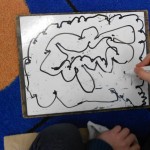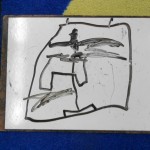We all know that art is an important part of children’s early learning and development, but doodling? And can it help with kindergarten readiness? Surprisingly, yes.
For play and learning:
- Art is another way to communicate and to express feelings and emotions.
- As children concentrate, they are practicing focusing skills and stretching their attention spans.
- Manipulating art materials helps develop small muscles and eye-hand coordination.
- There’s all kinds of problem-solving: what to do next, where to put something, how to use materials, and, of course, what happens if…followed by fixing or cleaning up materials and messes.
- Kids get to use their imaginations as they create and explore and connect with others, talking and interacting to support the development of social skills like sharing and taking turns.
- Using shapes and symbols gives brains practice making and using visual images.
Much of this also occurs when children are doodling. We sometimes think that doodling interferes with paying attention, but research is showing that it can help brains focus and remember information. It can be a way to release tension and frustration and can give children something to do. Doodling is also a form of visual language and is used in art therapy. The shapes, colors, and lines can be clues about what someone is thinking or feeling.
Instead of designs on walls, we can give kids paper and crayons for doodling, chalkboards and chalk, and even dry erase crayons and white boards. There are special soaps for doodle fun in the tub, and magnetic doodle boards that are especially good in the car.
Not all children or adults will have strong visual skills, but doodling is a way to have fun and learning. Is there time and space for a doodle play-of-the-day for your child?


